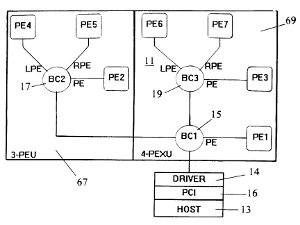 Fifth Generation Computer Corp. v. IBM, Dkt No. 2010-1201 (Fed. Cir. Jan 26, 2011) [PDF].
Fifth Generation Computer Corp. v. IBM, Dkt No. 2010-1201 (Fed. Cir. Jan 26, 2011) [PDF].
Fifth Generation sued IBM for alleged infringement of US patent 6,000,024, which is directed to binary tree parallel computing systems. It is well known that parallel computing systems attempt to increase processing speed by the use of multiple processors operating simultaneously.
The key issue in the case was how the term “root bus controller” in claims 1 and 7 should be interpreted. Claim 1 of the ‘024 patent provides:
A binary tree computer system for connection to and control by a host computer, comprising:
N bus controllers connected in a binary tree con-figuration in which each bus controller, except those at the extremes of the tree, are connected to left and right child bus controllers, where N is an integer greater than 2, one of said bus controllers being a root bus controller for connecting said binary tree connected bus controllers to said host computer;
N processing elements, one attached to each of said bus controllers;
N+1 leaf processing elements connected, two each, as right and left children to the bus controllers at the extremes of said bi-nary tree;
each of said processing elements including a microprocessor and a memory;
each of said bus controllers including, for each processing element connected thereto, a buffered interface connecting said processing element to said bus controller for transmitting instructions and data between the bus controller and the connected processing element, and means for writing information into the memory of the connected processing element without involving the microprocessor of said connected processing element.
Claims require “root bus controller” to have no parent bus controller. The court noted that patent claims function to delineate the scope of the claimed invention and give notice to the public of the patentee right, however this notice function would be undermined, the court said, if claims were construed so as to render “characteristics specifically described in those claims as superfluous.” The appellate court agreed with the trial court that root bus controller is necessarily the link between the binary tree of bus controllers and the host computer. Therefore the root bus controller is the “the bus controller at the highest order position of the binary tree computer system that connects the binary tree to the host computer and which has no parent bus controller.”
Fifth-generation argued that the root bus controller is merely the highest level bus controller for a sub-tree that could possibly connect to a parent bus controller as a part of a larger tree. The appellate court rejected this stating that if Fifth Generation’s arguments were to be adopted the language of claim one providing that the route bus controller is “for connecting said binary tree connected bus controllers to said host computer” would lose its plain meaning. Further the court found that the claim language required “one of said bus controllers” to be the root bus controller, and if this generation’s interpretation were adopted this element of the claim would be rendered superfluous.
Subject matter of patents incorporated by reference not necessarily imported into the claims. The second issue in the case was whether patents, disclosing subtress, incorporated by reference in the ‘024 patent supported Fifth Generation’s interpretation of the claims. The the court found that a patent does not need to expressly recite concepts disclosed in patents incorporated by reference in order to incorporate them into the later patent specification. Yet, this did not save Fifth Generation because the court stated that not every concept in prior art inventions necessarily are imported into every claim of the later patent through an incorporation by reference statement.
Judgment of Non-Infringement Affirmed.